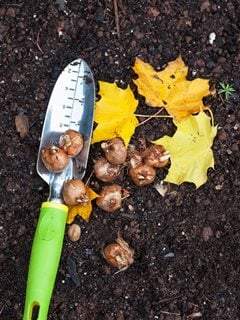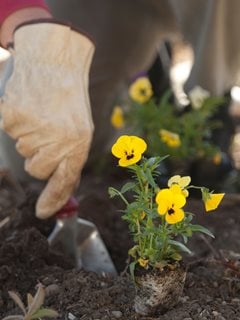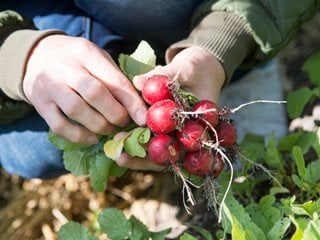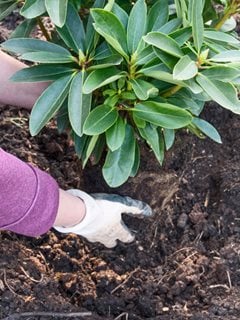What To Do To Your Garden In The Fall
To many, the arrival of Labor Day means summer is over, but for gardeners looking to stretch out the growing season, it signifies a new opportunity for planting. From early fall through most of November is one of the best times of year to plant spring-blooming bulbs, cool-season annuals and vegetables, as well as many trees, shrubs, and perennials.
On this page: Why Plant in Fall? | Spring-Blooming Bulbs | Cool-Season Annuals | Cool-Season Vegetables | Trees, Shrubs, and Perennials
On this page:
- WHY PLANT IN FALL
- SPRING-BLOOMING BULBS
- COOL-SEASON ANNUALS
- COOL-SEASON VEGETABLES
- TREES, SHRUBS, AND PERENNIALS
WHY PLANT IN FALL?
- Still-warm soil promotes good root growth.
- Cool weather eliminates the threat of heat stress on new plants.
- Increased rains help plants establish stronger root systems before winter.
- Many pests and diseases that plague gardens in spring and summer aren't as big of a threat in fall.
Additionally, "The more we accomplish in fall, the less hectic things will be in the garden next spring," say Nancy Ondra and Stephanie Cohen in their book Fallscaping: Extending Your Garden Season into Autumn. "It's prime time for setting out new plants, moving those that are out of place, and planting bulbs to brighten our gardens next year. It's also a super opportunity for stocking up on new plants at clearance sales, dividing overgrown clumps, taking cuttings, and sowing seeds."
If you've had little success with fall planting in the past, you may be choosing the wrong plants or you're not getting them in the ground soon enough before your region's typical first frost date. Here are some foolproof plants to put in your fall garden, plus tips on when and how to plant them for the best results.
You can find a good selection of perennials, shrubs, and cool-season annuals online from Proven Winners, or check you local garden center.
SPRING-BLOOMING BULBS

Crocus bulbs ready for fall planting. Photo by: Island Images / Alamy Stock Photo
What to plant:
Autumn into early winter (depending on where you live) is the peak time to plant spring-blooming bulbs, including tulips, daffodils, hyacinths, alliums, and crocuses. It's important to put them in the ground now because they need a long winter of beauty sleep to get ready for their spring coming-out party.
Starting in late summer, you'll find a wide array of spring-blooming bulbs in garden catalogs and local garden centers. But don't limit yourself to the most common varieties. Expand your garden-bulb repertoire by trying something more adventurous, such as these 18 Stunning Bulbs to Plant in Fall.
When to plant:
Wait to plant bulbs until nighttime temperatures drop to around 50 degrees or below for about two weeks to give the soil a chance to cool down so your bulbs don't emerge too early. To give bulbs enough time to root and get established, try to plant them at least six weeks before a hard, ground-freezing frost can be expected in your area (typically in October in northern climates, and November or later in warmer climates).
If you still haven't put your bulbs in the ground by early winter, go ahead and plant them as soon as there is a thaw or break in the weather. Leaving bulbs out of the ground too long will cause them to wither and dry out. Another option is to plant your bulbs in pots and allow them to overwinter in a holding bed or a sheltered outdoor spot, covered with several inches of mulch.
Planting tips:
- When purchasing bulbs, buy several varieties with a range of flowering periods so you can enjoy blooms from early to late spring.
- Bury bulbs with the pointed end up to a depth about three times their diameter (for most tulip and daffodil bulbs, about 6 to 8 inches).
- For the greatest impact, plant them in clusters of five or more, rather than sticking a single bulb in the ground.
- To camouflage the bulb foliage when it begins to die back in the spring, intermingle your bulbs with perennials that have similar foliage, such as daylilies and hostas.
For more specific information on planting times, pre-chilling (for warmer areas), and planting tips, see: How & When to Plant Bulbs
COOL-SEASON ANNUALS

Fall is a great time for planting cool-season annuals such as pansies. Photo by: Thom Gourley/Flatbread Images, LLC / Alamy Stock Photo.
What to plant:
By the time autumn arrives, our heat-weary, sun-parched gardens need an infusion of color. Cool-season flowering plants put on their best show in the fall and will often remain vibrant through November or longer. They don't mind frosty evenings and many will even tolerate temperatures down to the mid-20s.
Violas and their pansy cousins are among the hardiest and most colorful of the cool-season annuals. Others that can take the cold include sweet alyssum, snap dragon, osteospermum, dianthus, lobelia, and cornflower. Although chrysanthemums are actually perennials and best planted in the spring, they're often treated as annuals in the fall in northern climates and come in a vast array of hues that complement the autumn color palette.
Flowering annuals aren't your only options for adding flair to the fall garden. Alongside your pansies, plant some ornamental kale and cabbage, which have centers that turn lovely pastel shades of white, pink, and purple when the temperatures drop. Or try Swiss chard 'Bright Lights', an edible green often used as an ornamental foliage plant because of its multicolored stalks and attractive veined leaves.
When to plant:
If you're buying bedding plants from a local nursery, you can generally put them out in the garden as soon as they become available, but they will do best if you wait until daytime temperatures remain below 80 degrees. Some cool-season annuals, particularly pansies, are easy to grow from seed if they are sown in the garden in late summer.
Planting tips:
- Keep your fall annuals blooming longer by removing spent flowers.
- Where winters are mild, fall-planted pansies will often survive and rebloom in spring if protected by a layer of mulch.
- Mums may also come back to life the following spring if you plant them directly in the ground and cover them with a layer of mulch.
COOL-SEASON VEGETABLES

Plant seeds now and you'll soon be enjoying fresh radishes from the garden. Photo by: Anjo Kan / Alamy Stock Photo.
What to plant:
You can get a fall harvest by starting fast-growing varieties from seed or by purchasing transplants from local garden centers. Fall is a great time to plant another crop of spring greens such as spinach, leaf lettuce, arugula, mustard greens, and mâche because they require cooler soil for seed germination and they mature quickly.
Fast-growing root veggies such as radishes, beets, and turnips also thrive in cool conditions and take less than two months to mature. Fall is also a good time to plant onion sets and garlic cloves for harvest in late spring or summer of the following year. For more options, see 15 Picks for Your Fall Vegetable Garden.
When to plant:
To determine the optimal time to plant fall crops from seed, you'll need to do some math. Check the back of the seed packet for the "days to maturity" and then count backwards from the average date of the first hard frost in your area. Because the growth rate of your plants will slow as the days shorten, add an additional week or two to determine your sow-by date.
In most cases, you should stick with cool-season crops that mature in 70 days or sooner, unless you live in a climate with mild winters. If you're growing frost-resilient varieties or starting from transplants, you'll have a bit more wiggle room.
Planting tips:
- If planting seeds in an area where you recently harvested summer crops, just rake lightly to loosen the topsoil and work in a bit of compost or other organic matter to help retain moisture.
- You can also repurpose the pots you used to grow summer annuals by filling them with cool-season edibles, including lettuce, spinach, kale, chard, radishes, and carrots (see Growing Vegetables in Pots.)
- Take advantage of sales on cool-weather-crop seeds and buy more than you need. Save the remaining seeds for planting the following spring.
TREES, SHRUBS, AND PERENNIALS

Planting rhododendrons in the fall allows the roots to establish all winter before the plant bursts forth with new growth. Photo by: John Swithinbank / Alamy Stock Photo.
What to plant:
Fall planting of trees, shrubs, and perennials offers a number of advantages over spring planting. The cooler temperatures are easier on the plants, so there is less chance for them to suffer from heat stress, especially in warmer climates. When the air temperatures become cooler than the soil, new top growth slows, allowing plants to focus their energy on root development in the still-warm soil. The moisture from fall rains also helps trees and shrubs establish strong root systems.
Most deciduous shrubs can be successfully planted in fall. Spring-blooming broadleafed evergreens, such as rhododendrons and azaleas, also prefer fall or early spring planting.
When to plant:
For trees, shrubs, and perennials, allow at least four to six weeks before the ground freezes to give them enough time to become established. If you wait until the tail end of the fall season to plant (November or December), you run the risk of poor root growth.
Dividing perennials:
In addition to planting new shrubs and trees, fall is the best time to divide or move perennials that need more growing room, especially those that bloom in the spring or summer, such as daylilies, bearded iris, peonies, and garden phlox. Divide and move perennials at least several weeks before the average date of the first hard frost in your area so your plants have time to recover from transplant shock and establish new roots. (See When to Divide Perennials).
Planting tips:
- Most trees, shrubs, and perennials planted in the fall are no longer producing new top growth. Focus on providing ideal conditions for root growth by keeping them well watered until the ground freezes.
- Cover garden beds with several inches of organic mulch, such as shredded bark or leaves, to keep the soil warm longer and to minimize damage from winter freeze-thaw cycles.
RELATED:
Expert Plant Picks for Your Fall Garden
Autumn Gardening Guide
What To Do To Your Garden In The Fall
Source: https://www.gardendesign.com/autumn/planting.html
Posted by: brownleehatterouble.blogspot.com

0 Response to "What To Do To Your Garden In The Fall"
Post a Comment